Employee engagement is one of the most important metrics for any organization, but it can be challenging to figure out. This article will tell you exactly what employee engagement means, why you should care about it, how to measure it, and how to improve it.
Employee engagement has been a major focus for organizations and leaders since the concept first emerged in the 1990s, and especially over the past few years. Companies are realizing the massive impact engaged employees can have on business outcomes, and engagement efforts are more prevalent than ever.
Despite this increased attention, employee engagement can be challenging to define, and even more challenging to build. Right now, over three-quarters of employees worldwide aren’t actively engaged. It’s clear that companies need to take engagement efforts up a notch, especially with younger generations communicating higher standards for the workplace and the rise of remote and hybrid work necessitating creative, intentional approaches.
So, what does employee engagement look like in the modern workplace, and what are the best ways to measure and improve it? Read on to find out.
- Defining employee engagement
- Why employee engagement is important
- 6 factors that lead to employee engagement
- How to measure employee engagement
- How to improve employee engagement
- 7 ways your organization can improve engagement
- 1. Take employee listening seriously
- 2. Revamp your rewards and recognition
- 3. Foster a supportive, wellbeing-focused environment
- 4. Make the digital employee experience a breeze
- 5. Help employees build relationships
- 6. Empower your managers to improve engagement
- 7. Shout your values from the rooftops
- 7 ways your organization can improve engagement
Defining employee engagement
What is employee engagement?
Defining employee engagement can be tricky because it’s a multifaceted concept that encompasses several areas of the employee experience. We can probably all point to a co-worker, friend, or relative who seems “engaged” at work, but we may still struggle to pin down just what that means.
Gallup defines employee engagement as the “involvement and enthusiasm of employees in their work and workplace,” and SHRM describes it as “employees’ commitment and connection at work.”
In a nutshell, engaged employees care about and actively contribute to their organizations’ and teams’ successes. They are motivated by an emotional connection to their roles, making them more conscientious, more productive, and more likely to go the extra mile.
What does this look like in practice? Picture a school bus driver who commits every student’s name to memory and makes a point to brighten her passengers’ mornings with a joke of the day. Or an accountant who works late to correct a rounding error because they see themself as a partner in their client’s future and don’t want them to lose a single dollar toward their retirement. These are engaged employees.
Employee engagement isn’t just a state of being for employees, but also the strategy a company uses to get there. Looking at it from an employer’s perspective, Engage for Success defines employee engagement as “a workplace approach resulting in the right conditions for all members of an organization to give of their best each day, committed to their organization’s goals and values, motivated to contribute to organizational success, with an enhanced sense of their own well-being.”

Employee engagement is different from employee satisfaction, although the two terms are often lumped together. While satisfied employees are content with organizational factors such as work environment, compensation, benefits, and management, and generally have positive experiences with work, engaged employees are enthusiastic about what they do, thriving in their roles, and willing to go above and beyond to further their organizations’ goals.
A satisfied employee will show up on time and get the job done, but an engaged employee has a special sense of commitment that brings extra value to their workplace.
The spectrum of employee engagement
Thinking of employees as either completely engaged or completely disengaged ignores the nuances that will be present in your company. Experts are beginning to take a closer look at the employees who fall somewhere in between very engaged and very disengaged.
2023 research by McKinsey identified six categories of employees based on engagement, satisfaction, performance, and wellbeing. They estimated:
- 4% of employees were highly engaged
- 38% were “reliable and committed
,” - quitters or near-quitters (10%)
- disruptors who were actively disengaged and having a negative impact on the company and their coworkers (11%)
- mildly disengaged employees (32%) who displayed below-average commitment without being disruptive
By thinking of employee engagement as a spectrum, it’s easier to put ourselves in the minds of employees and consider how any efforts we make to improve engagement levels will impact different employees in different ways.
Small changes can make a big difference for a significant swath of workers who are already nearing engaged status. While these people may just need a little workplace nudge, others will require a great deal more. Figuring out what this looks like and tailoring our strategy to various types of disengaged workers through employee personas can be useful as well.
Employee engagement in 2024
Despite being key to any organization’s success, employee engagement is chronically low. A large-scale global survey found that only 23% of employees are engaged today, which means a whopping 77% of people are not giving or getting their best at work.
It’s essential for organizations to improve engagement due to its strong correlation with business outcomes (more on that below), but it can be difficult to know where to begin.
Free guide: Essential internal communications strategy
Why employee engagement is important
Employee engagement is one of the most important internal metrics your company can focus on because it impacts virtually every area of a business. Engaged employees can truly elevate your organization with their passion, workplace innovation, and high-quality work. On the other hand, low engagement takes a toll on business goals and profits, costing the global economy an estimated $8.8 trillion annually.
This makes sense when we look at the various business outcomes that are correlated with engagement. A meta-analysis of 456 research studies on 2.7 million employees found that high-engagement companies performed significantly better than low-engagement companies in several key areas. Companies with high engagement saw an 81% lower rate of absenteeism, 64% fewer workplace accidents, and 18% higher productivity levels. And what’s more, the results showed engagement also had a strong connection with large-scale outcomes not directly related to employees themselves. High-engagement companies scored 10% higher on customer loyalty and 23% higher on profitability.
Other research points to even more positive results from engagement. Employees who are energized and excited about work, an indicator of engagement, are 31% more likely to stay in their roles and contribute 15% more than those who are not. Engagement has also been linked to customer experience, with 60% higher engagement reported at companies with top levels of customer experience.
The data is clear. If you want a workplace filled with employees who show up for you, do their best work, take care of your customers, stay in their roles for longer, and further your business goals, engagement should be your top priority.
6 factors that lead to employee engagement
Employee engagement isn’t tied to a single area (or even two or three areas) of the employee experience. High engagement levels result from a combination of factors, and by working to understand what these factors are, you’ll be in a better position to measure and improve engagement at your organization. Here are 6 ways engagement presents in the workplace.
Alignment with the organization
Employees who understand and identify with an organization’s mission, vision, and values tend to be more engaged. Viewing the company’s purpose as important creates motivation and meaning around their work, and being part of something that matters helps them feel good about what they do every day.
Free guide: Essential internal communications strategy
Alignment with one’s role
Employees are more likely to be engaged when they feel they’re in the right role for them.
This is partially due to the sense of empowerment that comes from knowing that they can make an impact at work. The feeling an employee gets from developing an innovative approach to a common problem or closing a big deal results in enthusiasm for the job and a desire to continue achieving. This is even more pronounced when there are minimal roadblocks to getting things done – employees with the flexibility and resources to be effective are more likely to be engaged.
Recognition
Another piece of the engagement puzzle is recognition. Employees who report that their organizations have “great recognition” are 20 times more likely to be engaged than employees who receive poor recognition. This makes sense – being told our contributions matter reminds us that what we do is important and makes us more likely to make similar contributions in the future.

A supportive workplace
When employees don’t have the right support at work, it makes them feel like they’re swimming upstream, alone.
Support is also about having people who care. In a high-engagement organization, this support comes from multiple sources:
- Organizational: An organization that champions employee wellbeing (including mental health) and professional advancement is a huge driver of engagement.
- Managerial and leadership: When employees feel that someone is invested in their wellbeing and success, they become more engaged. Coaching, mentorship, and frequent check-ins about how they’re doing are key.
- Peer-to-peer: It’s also important for employees to see that their coworkers care about them. A culture of care makes employees more emotionally invested at work.
Interpersonal satisfaction
Humans are social creatures, and the social aspects of work are key to promoting engagement. Engagement goes up when relationships with the people we interact with, whether it be peers, superiors, or subordinates, are enriching and productive. Employees who report having a best friend at work are seven times more likely to be engaged and, according to SHRM, workers consider their relationships with co-workers (77%) and managers (74%) to be among the top drivers of engagement.

Clear, two-way communication
The quality of internal communication in the workplace also has a strong impact on engagement. Siloed organizations with barriers between employees in different departments, locations, and types of roles (for example, deskless versus office workers) create frustration and disconnection, making it less likely for employees to be engaged in their roles.
To promote engagement, communication needs to be bidirectional. 74% of employees who feel their voices are heard report feeling more engaged at work, so a culture of employee listening is essential. What does this look like? Plenty of opportunities for upward feedback and idea-sharing, as well as evidence that employee opinions are taken seriously.

How to measure employee engagement
Just as it can be challenging to define employee engagement, it can also be hard to measure it. While there are a wide variety of employee engagement indicators to look at when gauging your performance, there’s no single metric that accurately measures employee engagement levels.
That being said, through a combination of several methods and metrics, you can get to the bottom of how to measure engagement at your organization. Here are a variety of techniques you can use to assess your progress.
Free guide: Essential internal communications strategy
Asking the right questions to measure engagement
Before we get into ways to measure employee engagement, you’ll need to think about what questions you’ll be asking your employees. And you may have to get creative.
Because they may have varying understandings of what engagement means, asking employees directly about their engagement levels (i.e., How engaged do you feel?) isn’t the best approach. Try coming up with several questions that touch on different facets of engagement. The examples below are a great place to start and can be modified to be more open-ended for interview-based formats such as focus groups.
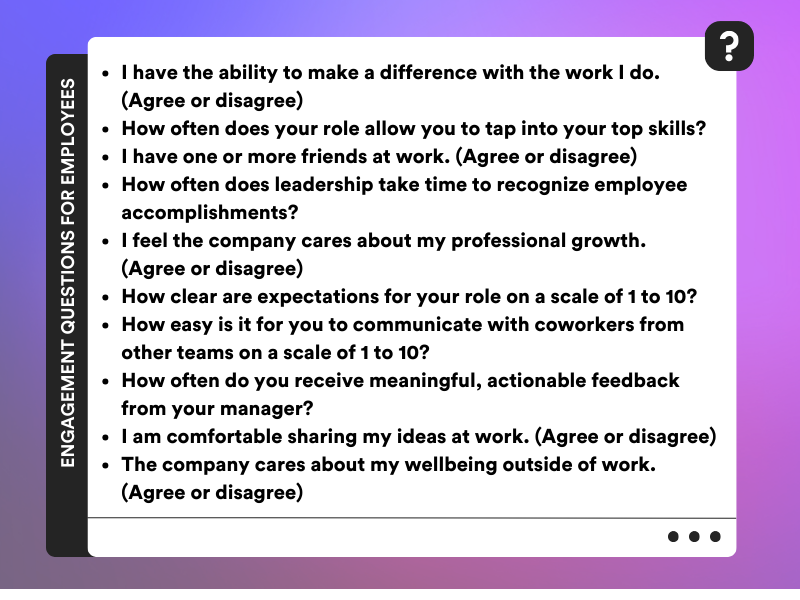
Employee surveys
Pulse surveys
Pulse surveys are a tried-and-true way to check in on how employees are doing, including their engagement levels. One benefit of pulse surveys is that they don’t require much time commitment from employees, so you’ll get higher participation than you would from sending a longer survey.
Simple multiple-choice or scaled questions further reduce the effort required to complete them, while still getting the level of detail you need to examine engagement more deeply.
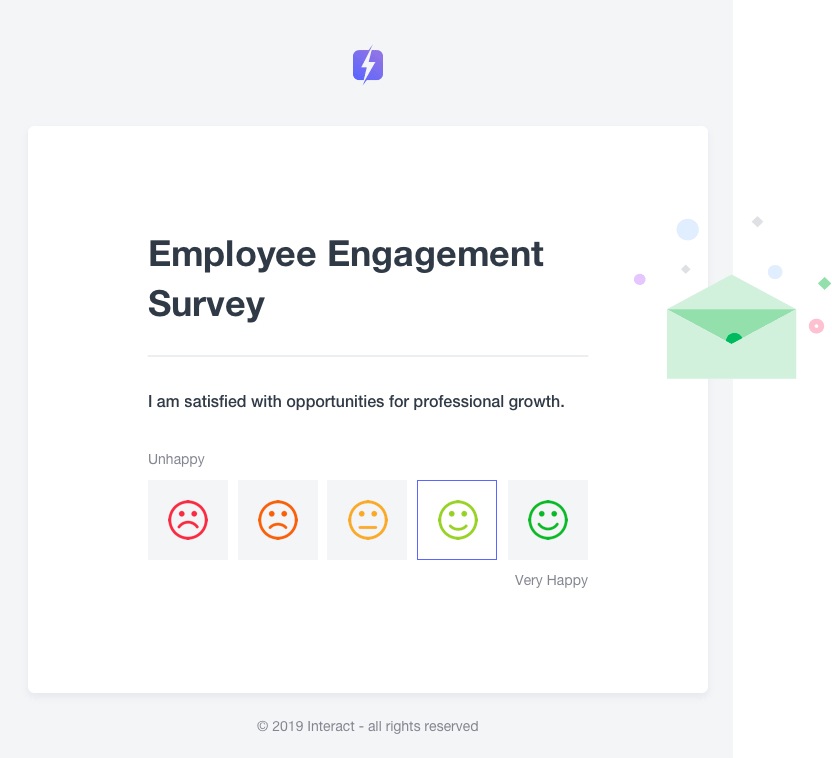
Another advantage is the ability to check in regularly over time to establish a baseline and identify any dips in engagement as soon as possible so that you can do damage control if need be. With pulse surveys, you likely won’t be caught off guard by sub-par results from an annual survey – you’ll get advance warning when things aren’t quite right.
eNPS surveys
An Employee Net Promoter Score (eNPS) survey, which can be sent as a pulse survey, can also help you measure employee engagement. It asks one simple question of employees: On a scale of one to ten, would you recommend your organization as a place to work? Some eNPS surveys also have a second, open-ended question that asks employees why they selected the rating they chose. This brings more nuance to the results but doesn’t count toward your final eNPS score.
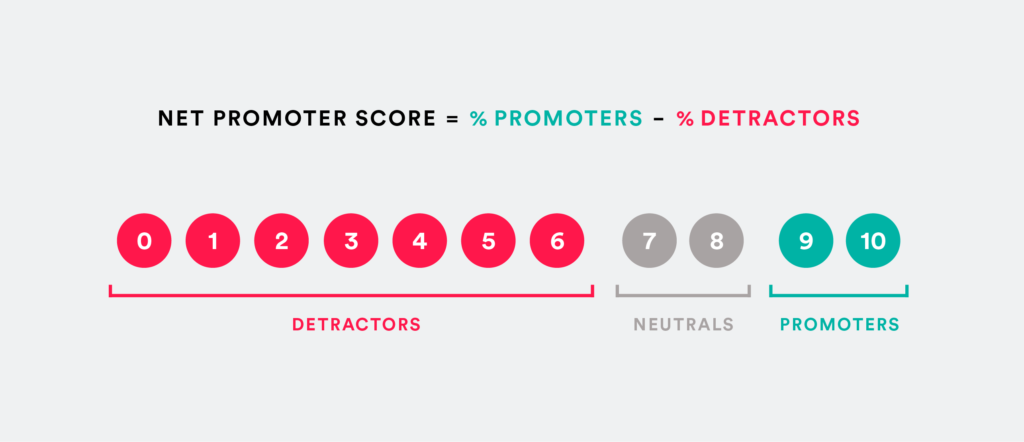
It’s important to note that a whole-company eNPS shouldn’t be the only metric you use to measure engagement. As an organization-wide result, eNPS may ignore team- or role-based differences – for example, high scores in marketing and low ones in IT.
Annual engagement surveys
Although short pulse surveys have their advantages, it can also pay off to complement them with more detailed questionnaires at less frequent intervals. Long-form engagement surveys are useful in thoroughly measuring all facets of engagement, so you can really laser in on more nuanced factors such as interpersonal satisfaction and employees’ alignment with their roles, which may be hard to adequately measure in a shorter format.
Unlike pulse surveys, an annual engagement survey may require a more aggressive internal comms campaign, as employees will see it as a larger time commitment and may be hesitant to complete it. Be prepared to push the survey across channels, including email, your intranet, all-hands meetings, and manager cascades, to drive up participation.
A note on survey quality
The right features can make a difference in your ability to truly measure engagement with a survey. You’ll want to find a survey provider that allows you to break down results in a detailed manner, by department, location, or type of role, for example.
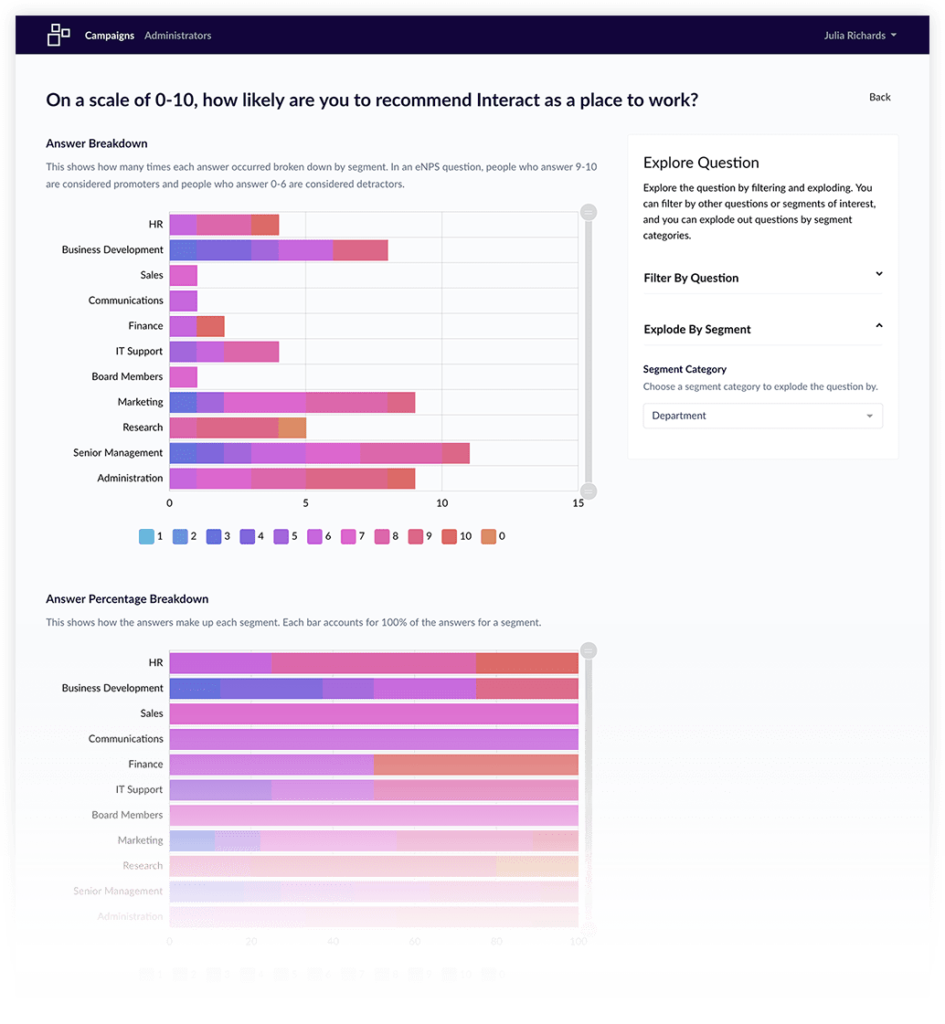
It’s also helpful to find a platform that allows you to target a specific audience for follow-up polling based on the results you get. If deskless workers have low engagement, it’s worthwhile to ask them a few additional questions to get to the root of the matter.
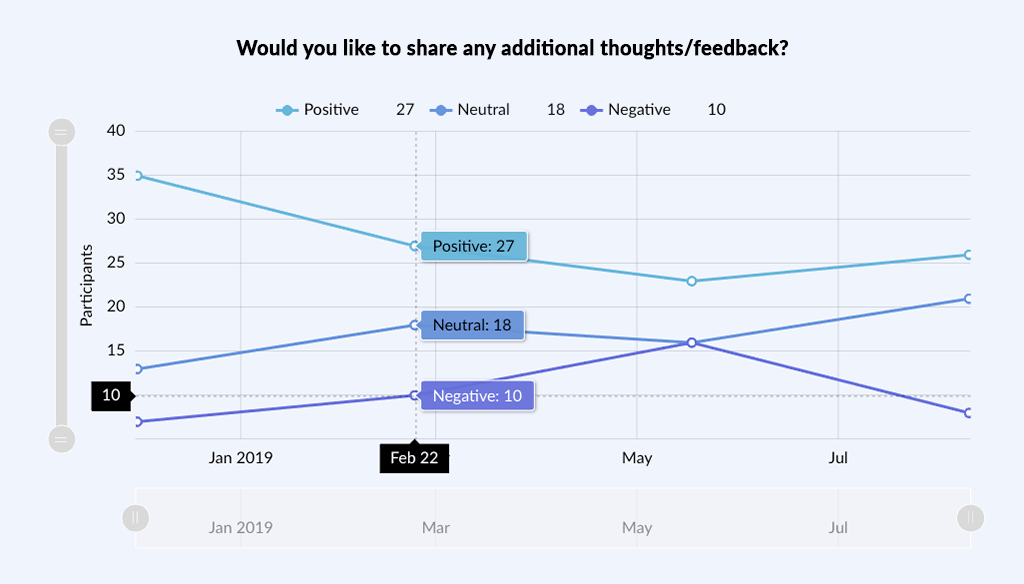
Another handy feature to look for is sentiment analysis. While free-form questions are a great way to get a candid look at how employees are feeling, all those answers can be hard to translate into workable data. Sentiment analysis automatically analyzes and grades your survey answers, so you can see if employee responses were positive, negative, or neutral.
Interview-based engagement assessments
While quantitative measurements are key, qualitative ones can give you a more nuanced picture of employee engagement at your organization. This can be done in several interview-based formats, including:
- Questions in regular performance reviews with managers
- Focus groups that specifically target engagement
- Questions in existing interviews that occur at various phases of the employee lifecycle such as 90-day check-ins or exit interviews
Interviews capture those employees who are hesitant to fill out a survey – maybe they brush off the notifications so they can get on with their work, or perhaps they prefer speaking to writing. Whatever the reason, a conversation with a human being may be just what they need to open up and share important insights into their engagement.
Free guide: Essential internal communications strategy
How to improve employee engagement
7 ways your organization can improve engagement
1. Take employee listening seriously
If you’re serious about improving engagement, you need to build a culture of employee listening. 86% of employees feel that people at their organizations are not heard fairly or equally.
To maximize impact, ask for feedback and employee ideas often and over several channels, including in all-hands meetings, your internal comms, official surveys, and interviews.
Employee idea management software provides a centralized place for employees to submit their thoughts. It can also do double duty by serving to automate feedback, including giving employees updates on the status of their submissions. This is especially important because, to truly build engagement, you need to act on feedback in addition to collecting it.
In the same vein, if you crowdsource employee ideas and put them into action or make changes based on recent survey results, give credit where credit is due – your audience will be happy to learn that employees are being listened to.
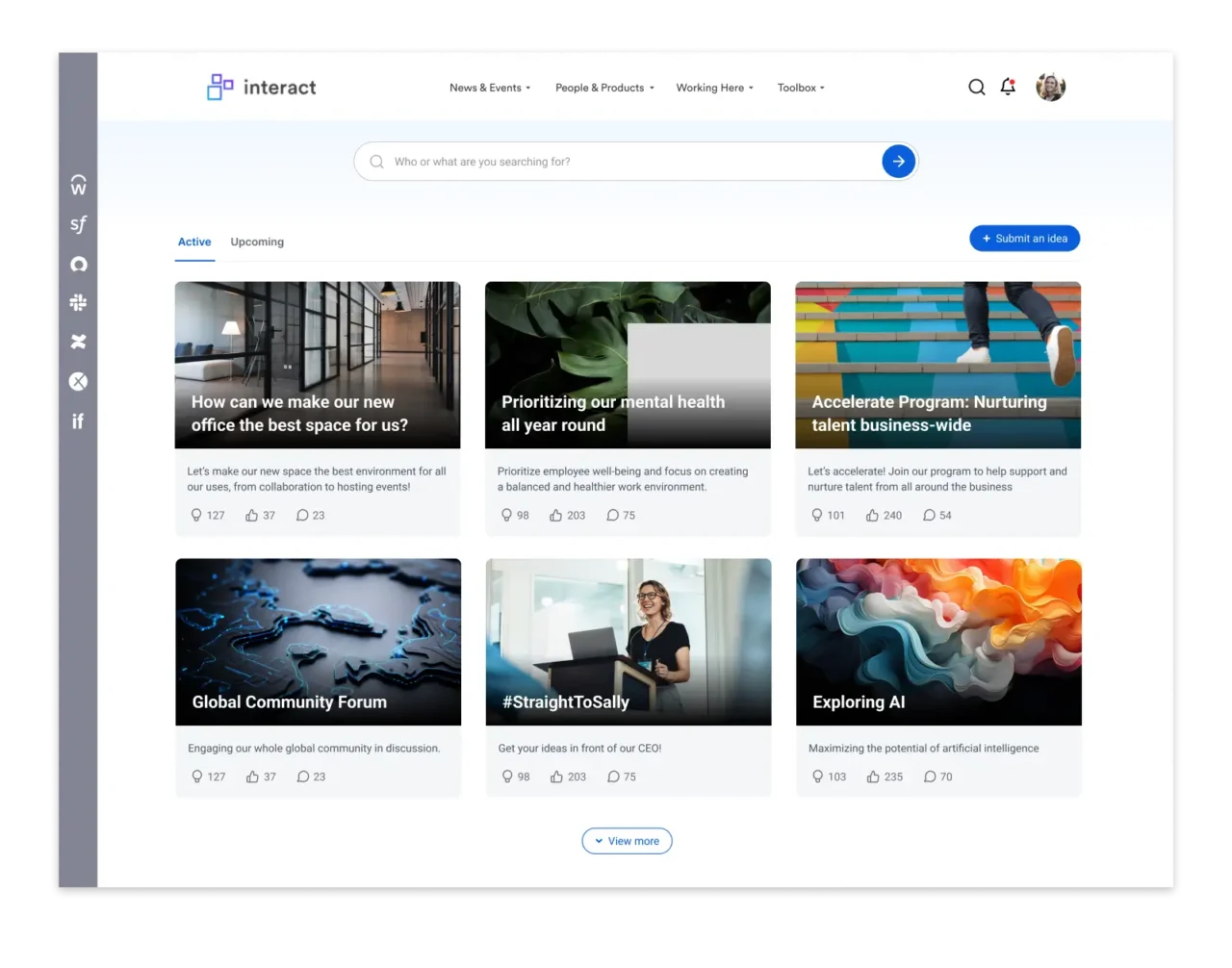
2. Revamp your rewards and recognition
A culture of recognition will have a measurable impact on your organization’s engagement levels. Implementing a company-wide recognition program is a surefire place to start – employee engagement is 14% higher at organizations with recognition programs than at those without them.
Your recognition strategy can include more traditional elements like employee awards, a “wall of fame,” or thank-you gifts, along with a variety of digital tools that enable both top-down and peer-to-peer recognition.
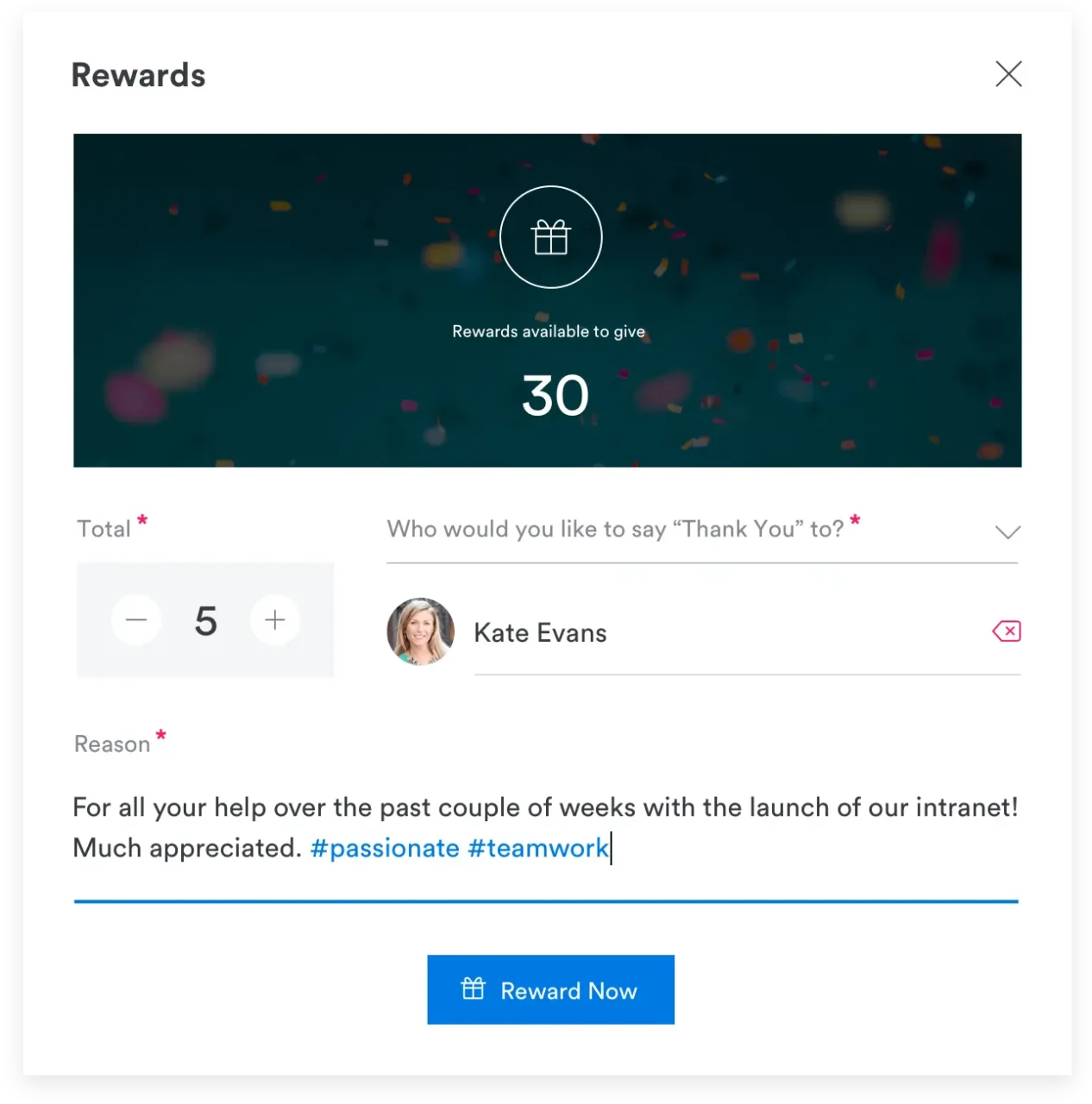
A points system is a great way to empower employees to recognize one another. Users can give their coworkers points, which can be redeemed for rewards later, providing additional incentives and recognition for hard work. These points can also be used to inform decisions about top-down recognition methods, such as annual awards for shining stars, employee of the month or quarter, or a regular recognition segment in your newsletter or all-hands.
3. Foster a supportive, wellbeing-focused environment
Employees are more engaged when they feel their employers care about them and support them as individuals, so tell them – and show them – you care. Make your commitment to their wellbeing known by devoting regular initiatives and internal communications to the topic. This could be an intranet post that shares how to recognize the signs of burnout, a guest speaker to mark Mental Health Awareness Month, or a company-wide challenge to get more steps in.
Another aspect of support is giving employees flexibility in getting their work done. If you’re able, consider adopting flexible working policies, whether that’s the option to work from home some or all the time, or flex scheduling that helps employees squeeze in caregiving duties or periods of uninterrupted focus.
You should also work to highlight any company programs that could be helpful to employees’ wellbeing, such as flexible work, gym stipends, or employee-run support groups. It’s not enough to simply offer these programs, you need to encourage their use, too. A dedicated section on your intranet software can provide this information in a single place so that employees are more likely to take advantage.
4. Make the digital employee experience a breeze
Improving employees’ digital experiences sets them up for engagement by reducing friction, providing the right resources, and clarifying company expectations.
Make sure employees can find what they need, when they need it, by making crucial information easily searchable and accessible in a single location. The ability to access information on your product, company policies, and key updates from various departments will make it easy for employees to do their jobs and free them up to focus on the aspects of work they’re most passionate about. The transparency it provides is an added win for engagement.
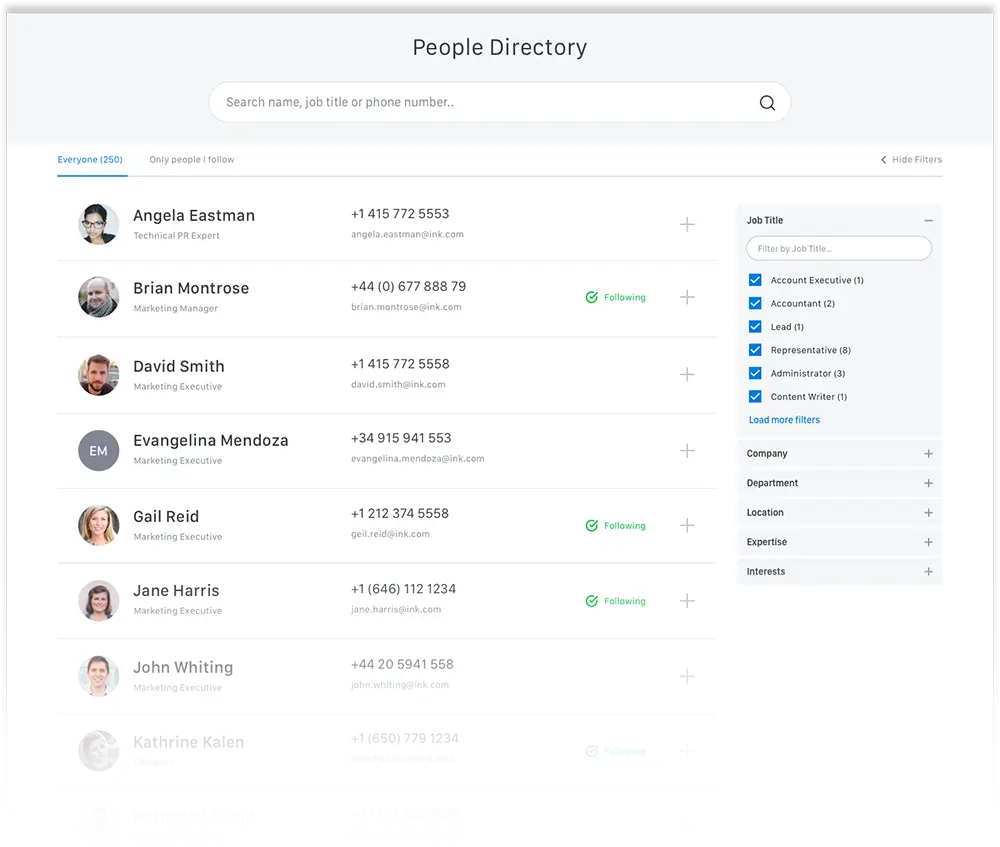
It’s also important to make it easy to get in touch with and collaborate with various people from different parts of the organization, especially in dispersed, remote, or hybrid setups. Ensuring employees have the right tools to facilitate this collaboration reduces silos across teams, roles, and time zones, improving the work experience and helping everyone feel more effective in their roles.
5. Help employees build relationships
To improve engagement, you’ll need to improve connections and relationships among employees. Workplace camaraderie doesn’t happen overnight and oftentimes needs to be nudged along a bit through structured initiatives and events.
Create organization-wide opportunities for bonding, including charity events such as volunteer days or celebrations such as holiday or employee appreciation parties. Offering more intimate ways to get to know colleagues on a social level works well too. Try starting an office book club, or a virtual “coffee buddies” program, where people are matched up randomly with a coworker in another department every few weeks for a non-work chat.
Your intranet is another great way to foster interpersonal connections. Encourage employee blog posts on topics of personal interest and suggest that new hires fill in their people directory profiles with fun facts, hobbies, and pets in addition to professional information.
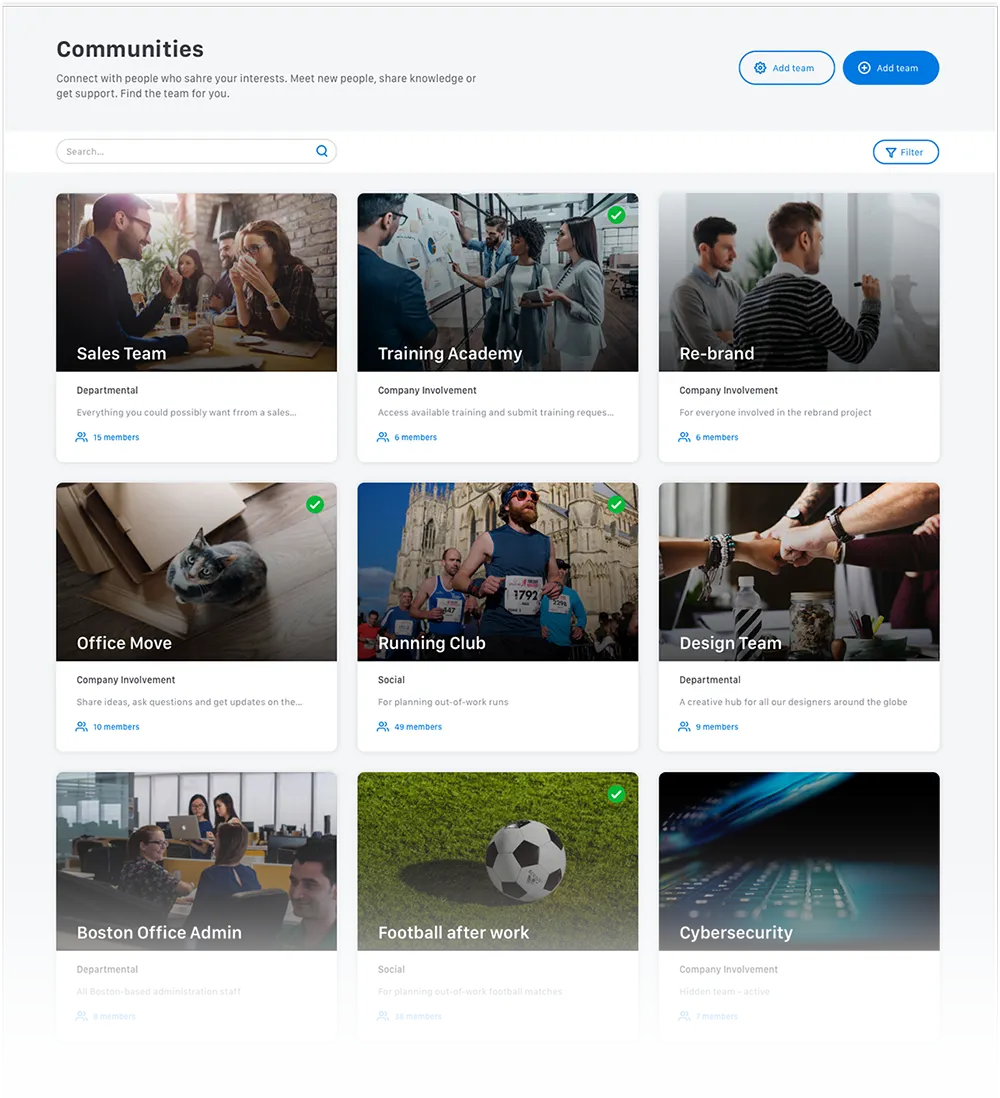
Provide designated relationship-building areas with communities for shared interests, where fellow chess players, knitters, or travel aficionados can bond. Social features, such as liking, commenting, and tagging, encourage employee interactions across your digital workplace and make the whole experience even more engagement-friendly.
6. Empower your managers to improve engagement
Managers are a core piece of the engagement puzzle, accounting for up to 70% of the variance in engagement levels across business units. But managers aren’t born to engage employees – they need the right training and tools to get the job done.
A strong performance review system is key, as check-ins on goals and progress, clear expectations, and bidirectional feedback are all crucial to engagement. Standardize your processes, figuring out the best cadence, structure, and metrics to set managers and employees up for success. In addition to these more formal reviews, one-on-ones are key, so make sure managers are clear on how often they should be meeting with their reports.

To drive engagement, managers should serve as coaches and mentors. Provide formal training to share tactics on helping employees reach their full potential, and how to combat any common problems.
You can also utilize your managers in communication cascades to share company messaging. Employees may feel more in the loop if they hear important news from someone they have a strong relationship with, so utilizing this method can grow engagement and boost feelings of transparency throughout the organization.
7. Shout your values from the rooftops
A connection with company values drives engagement, but to establish this connection, workers must be clear on what these values are. This may seem basic, but it’s a topic worth addressing, as less than half of employees are confident that they know what their organization stands for.
Reiterate your values often in as many places as you can: all-hands meetings, your digital workplace, messages or blogs from leadership, your email newsletter, and anywhere else that’s relevant.
Employee recognition can be a natural place for value connection, for example. Ask your employees to tag one of your values when giving kudos on your recognition platform, or tie each of your annual company awards to one of your core values. Reminding employees of these values drives home a sense of purpose and helps them remember why they show up to work each day.






